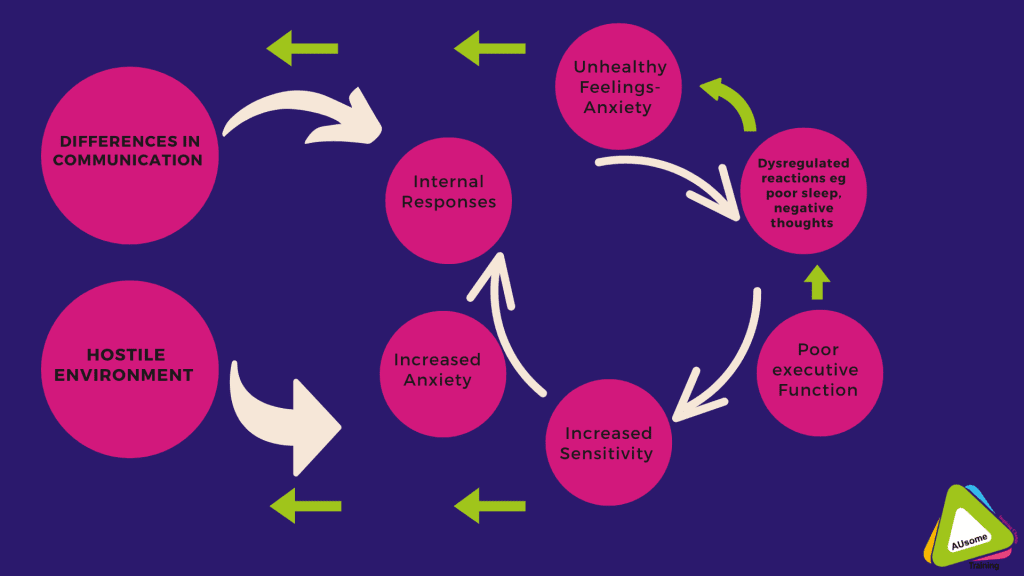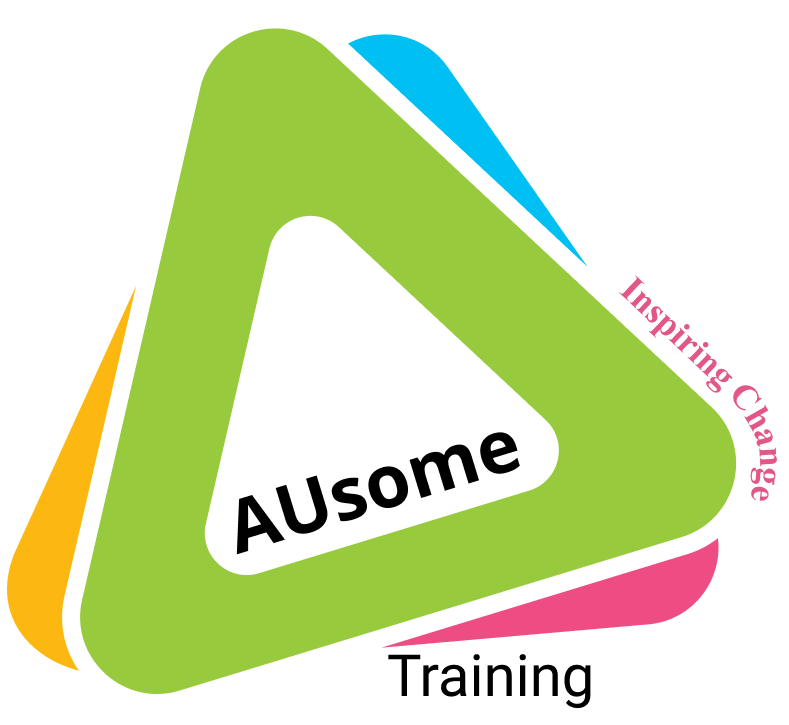Anxiety is a complex and multifaceted emotion that can manifest in various ways. It goes beyond the traditional understanding of simply feeling worried or stressed. For Autistics anxiety can take on different expressions, influencing our actions, thoughts, and interactions. By exploring the different expressions of anxiety, such as flight, fight, freeze, fake, and fawn, we can gain a deeper understanding of the challenges faced by anxious Autistics and offer appropriate support.
Flight: Running Away, Hiding, and Seeking Escape
Flight is an expression of anxiety characterized by a strong urge to escape from overwhelming situations. Autistic people may engage in actions like running away, elopement, or seeking solitude to find relief from our anxiety. We may also employ strategies such as hiding, or making excuses to leave in an attempt to create distance from stressors. For a teenager in school this might look like them putting up their hood in class to physically hide. When this is met with understanding then the outcome is far better then when it is met with an assumption that the pupil is disinterested or “looking for attention”. Likewise the younger child might say they have a pain in their tummy and ask to leave. In the workplace an Autistic colleague might need time on their own or avoid interactions with co-workers. Avoidance is a preemptive strategy to keep ourselves safe. If we avoid the situation then we also avoid potential risk. It’s a smart strategy but it can have negative repercussions like isolation and self-exclusion.
Flight can also manifest as escaping into our internal world. This can look like day dreaming or lots of activity with vivid movements (which is basically stimming to show what is going on inside.) A child might engage in this sort of self-preserving activity at lunch time when they spend time on their own to the outside observer but are engaged in a rich internal world on the inside.
We can also seek solace in familiar and comforting routines or activities. If things are predictable then there is less chance of harm. By following routines we minimise our risk of pain, social rejection and other unpleasant experiences often endure. So when a colleague or friend seems to “overreact” to change it’s important to realise that really there is no such thing as “over-reacting”. We react to the change because it can mean harm to us, it’s more difficult to calculate risk in an unpredictable situation and we are constantly monitoring our environment, our energy levels and managing high anxiety. It’s a vicious cycle.

As you can see from this diagram unless the social and physical environments change then we can’t break the cycle of anxiety for Autistics. It will keep alive under the surface no matter how well we may appear to “cope” .
Dissociation can also be understood as a flight response. If we retreat to our safe internal worlds then we can disconnect from what is happening to us. This is a common trauma response. It’s useful in the short-term to protect ourselves but has lasting long-term negative effects.
Fight: Defiance, Control, and Routine
Fight is another expression of anxiety where people exhibit behaviours associated with resistance or defiance. Autistic individuals may experience heightened anxiety that leads to lashing out, shouting, or exhibiting what may be perceived as “aggressive” behaviours. In reality, these behaviours often stem from a need for control and predictability, as well as a strong attachment to established routines. The fight response is a coping mechanism aimed at restoring a sense of order and reducing anxiety when we feel under stress. As humans, we also don’t just engage in one stress response at a time. They overlap. We experiment and we use the ones that we have learnt are most effective at keeping us safe. As you can see in this example fight response can exist alongside flight response and our need for control and predictability grows from many stressful encounters in our lives- these start at a very young age. We learn ways to protect ourselves.

Freeze: Mind Blank, Loss of Speech, and Restricted Breathing
The freeze response to anxiety involves a sense of immobilization or feeling “stuck.” Autistic individuals experiencing this expression may have our minds go blank, making it difficult to think clearly or express ourselves verbally. A very human response. This is why we have phrases like “I was lost for words” , “I’m speechless” because we understand that this is a very human response to stress. For some of us it can extend to situational mutism where we lose ability to speak. This can happen to children and adults when we “clam up”.
We may also exhibit restricted breathing or even hold our breath, often accompanied by a profound sense of dread or foreboding. The freeze response is a way for the person to protect themselves from perceived threats or overwhelming situations.
It’s important to understand stress responses and what they look like. Often stress responses are misinterpreted and the reactions of others can actually end up adding anxiety instead of reducing is.
Fake: Masking and Conforming to Fit In
The fake response to anxiety involves adopting a mask or facade to fit into social situations. Autistics may develop strategies to hide our differences and appear “neurotypical” in order to avoid standing out or facing potential rejection. This may involve laughing at ourselves, engaging in class or office clowning, or trying to be seen as equal or better in order to mask our anxiety. The fake response is a means of self-preservation and maintaining a sense of belonging.
Of course Autistic masking goes far beyond just trying to blend in (insert link to masking blog). It is a response to extreme stress and traumatic social interactions. It is a way to maintain our safety but it means that many of us live in a half-existence, disconnected from ourselves.
Fawn: People Pleasing, Overthinking, and Conflict Avoidance
The fawn response to anxiety revolves around seeking approval and avoiding conflict. Autistics may engage in people-pleasing behaviours, constantly evaluating social situations and interactions, and mimicking the behaviours of others. We may also experience heightened overthinking and be constantly on high alert for potential threats. The fawn response is an attempt to navigate social dynamics, maintain relationships, and minimise the risk of rejection or confrontation. Fawning and faking often go together. Fawning means that we study others and try to pre-empt what might happen, what they’re thinking about us and how to best respond to them. This is exhausting and means that we are constantly on high alert during social interactions. We may of course cover all of this up with a big smile while inside we are shrinking, feeling small and wishing the ground would swallow us up. All of this leads to very blurry boundaries.
Conclusion
Recognising and understanding the diverse expressions of anxiety in children and adults is crucial for providing effective support and fostering a more inclusive environment. By acknowledging that anxiety can manifest as flight, fight, freeze, fake, or fawn, we can approach people with compassion and tailor our interactions accordingly.
It is important to remember that each expression serves as a coping mechanism in response to anxiety-provoking situations.
The ultimate goal is not just to support Autistics to “cope” with anxiety and high levels of stress on an ongoing basis but to develop a more inclusive social environment where we don’t have to feel under stress.




